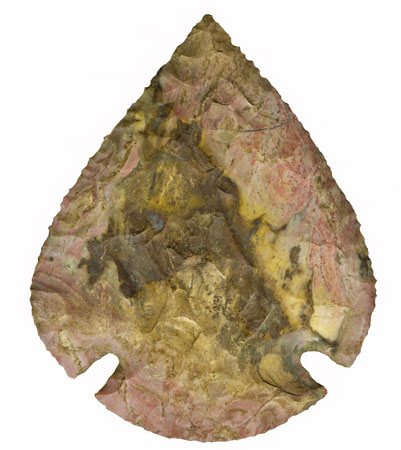
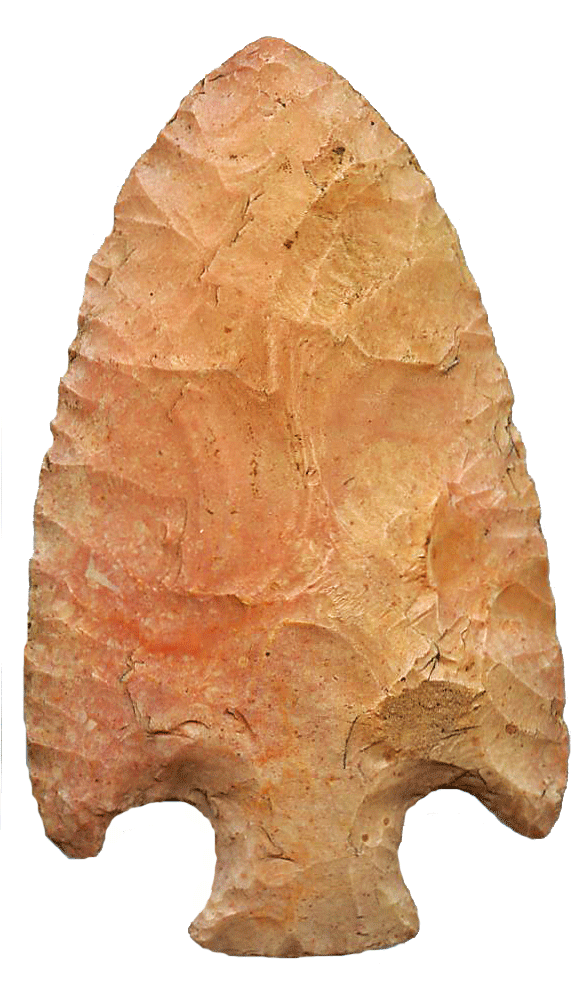
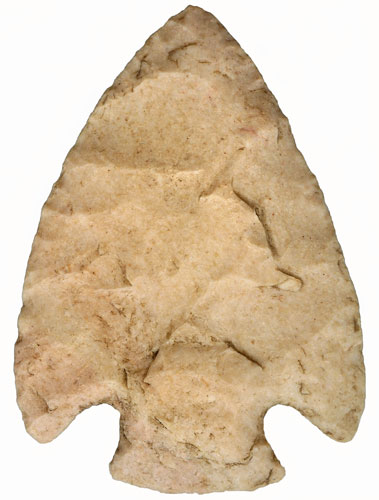



Point Type: SNYDERS
Also See: Affinis Snyders, Bay de Noc
Side Notched, Big Creek, Buck Creek
Barbed, Burnt Bluff, Gibson, Grand , Hamilton Stemmed, Hopewell - Snyders
, Lowe Flair Base,
Manker Corner Notched, Motley, North, Norton Corner Notched, Ross
Location: Midwestern to Eastern United States
Associated Dates:
2500 - 1500 B.P. - Woodland
Morphology: Corner
Notched
General Description: The Snyders type is a medium to large sized, ovate, corner notched, expanding stemmed, wide, thin, dart point or blade which was carefully made and is usually of high quality workmanship. The corner notches are wide, expanding, and deeply cut at a diagonal and are usually well-rounded. The notches result in the formation of broad, bold and flaring barbs when in the new, unreworked condition. The shoulders project downward. The stem is expanding, having a convex basal edge and concave side edges and appears to be short in relation to the overall length of the point. Some specimens exhibit only a slightly convex basal edge and others have a straight basal edge. Blade edges are excurvate when the point is not reworked and then become straight to incurvate as the blade was resharpened several times. The classic holotype has tiny barbs on the basal corners. Grinding may or may not be present on the basal edge.
It is believed that the preform for the Snyders point is the called the North blade.The Snyders is a Middle Woodland Hopewellian culture artifact. Snyders points are found in Illinois, southwestern Michigan, eastern Missouri, Wisconsin, Iowa, Indiana, Ohio, Pennsylvania, New York, northeastern Oklahoma, northwestern Arkansas and southeastern Kansas. Many examples exhibit heavy use wear as scrapers and many were transformed into hafted scrapers. Many examples exhibit extensive resharpening which has reduced the excurvate blade edge outline to a straight or incurvate blade edge. This indicates that the Snyders were utilized as knives.
According to Gregory Perino, "the Snyders point has a much broader range of shapes than heretofore illustrated as homotypes in point typology guides. These variants range from narrow to broad, some specimens depending on how much they had originally been resharpened and how wide the preform was originally. Points referred to as Affinis Snyders (Winters) are Snyders-like points of unknown cultural affiliation." The Manker Corner Notched is a smaller counterpart of the Snyders. Many Snyders points are made of a white or light colored cherts from quarries in Missouri or Illinois. Most specimens found in Indiana and Illinois are made from Burlington flint. Many Snyders that are found in southern Indiana and western Ohio are made of Harrison County, Indiana, grey flint. The Grand point type and the much older Big Creek point type are similar in outline to the Snyders and could be considered part of the Snyders cluser."
The size of
the Snyders point can range from 42 mm to 152 mm in length with the typical
point being in the 56 mm to 69 mm range. The average width of the blade is
between 40 mm and 54 mm. The average stem width is 26 mm with an average basal
width of 28 mm and an average stem length of 15 mm.
The Snyders point type was named by Edward G. Scully in 1951 for
the Snyders Hopewell site in Calhoun County, Illinois.
About The Point Above (Left): The large sized Snyders point pictured at the top left of this page, was found in Seneca Co. Ohio and is from the Tim Veach collection. The point is 81 mm long, 67 mm wide, stem width at the neck is 35 mm and basal width is 45 mm. The stem length is 17 mm. Thickness is 8.3 mm at the neck of the stem. The point is made from a multi-colored, heat treated Flint Ridge chert that is quite heavily patinated and encusted with mineral deposits of some sort. There is no basal grinding on the stem. This point is quite beautiful to behold and is in excellent condition with no dings. It is probably an unreworked specimen in as new condition and features a flairing wide stem with very narrow notches. Catalog Number 108-61-R
About The Point Above
(Center): The
large Snyders blade pictured above on the top center of this page was
found in Indiana and is from the former Tim Veach collection. The
blade is very well made and has a high level of suface
patination. Although the blade edges show edge retouch flake
scars, the blade edges are quite dull and show a polish from use
wear. The blade is 78 mm long and 47 mm wide. The stem is 14 mm
long and 16.5 mm wide at the neck and the basal width is 20.5 mm
wide. The thickness is 9 mm at mid blade. There is no basal
grinding on the stem. Catalog Number 114-66-R
About The Point Above (Right): The large Snyders blade pictured above
on the top right of this page was found in Indiana and is from the former
Tim Veach collection. The blade is knapped with fairly
crude percussion flaking and appears to be made from Jeffersonville
chert. The blade has a very high level of suface patination. Although the
blade edges show bifacial retouch flake scars, the blade edges are quite dull
and show a polish from use wear. The blade is 78 mm long and 56 mm wide.
The stem is 15 mm long and 23 mm wide at the neck and the basal width is 28
mm wide. The thickness is 8 mm at mid blade however most of the blade is
6.2 mm in thickness. There is some basal grinding on the stem and the stem
sides. Catalog Number 107-41-R
About The Point Below (Left): The medium sized Snyders blade
pictured below on the left hand side of this page was found near
Yorktown, Indiana and is from the former Les & Gus Donovan collection. The
blade is knapped with percussion flaking and appears to be made from a
heat treated Jeffersonville chert. The tip has dark gray inclusions
as does the base. The blade has a very high level of suface patination.
The blade edges show bifacial retouch flake scars. The blade is 60 mm long
and 44 mm wide. The stem is 12 mm long and 19 mm wide at the neck and
the basal width is 23 mm wide. The thickness is 7.3 mm at mid blade however
most of the blade is 5.6 mm in thickness. There is some basal grinding
on the stem and the stem sides. Catalog Number 113-51-R
About The Point Below (Right): The small sized Snyders point pictured at the bottom right of this page, was found in a drainage ditch somewhere along Interstate 65 (northbound) in northeastern Indiana in 1971. I was hitchiking with a friend to Chicago from Oxford, Ohio (Miami University) during a Thanksgiving break at school. Rides were few and I had to "see a man about a horse", if you catch my drift. I headed down into a dry drainage ditch for a bio-break. As I am was taking care of "business", I glanced over to my right. There at the bottom of the ditch, laying right out in the open is the little white Snyders or Affinis Snyders. The point is 50 mm long, 36 mm wide, stem width at the neck is 20 mm and basal width is 28 mm. The stem length is 14.5 mm. Thickness is 8 mm at the neck of the stem. The point is made from a glossy white chert that is quite heavily patinated and encusted with mineral deposits of some sort. There is no basal grinding on the stem. Catalog Number 90-40-L
References: Bell (1), Converse, DeRegnaucourt (1), Dragoo (f), Fogleman, Justice (1), Overstreet, Perino (1), Waldorf
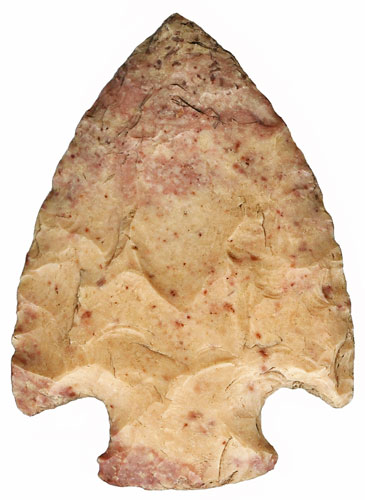
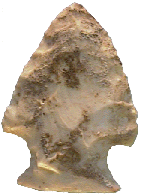
© Copyright 1997 - 2009 LITHICS-Net WWW.LITHICSNET.COM
Use your Browser's BACK Button to return to the LITHICS-Net Index.